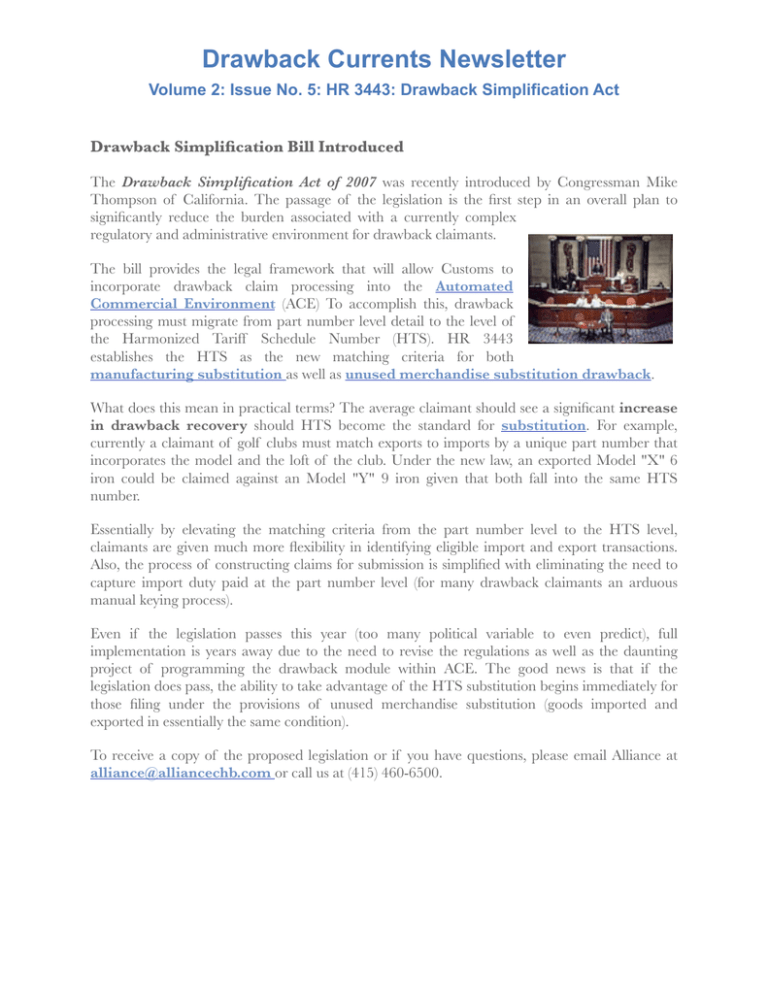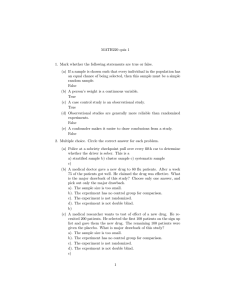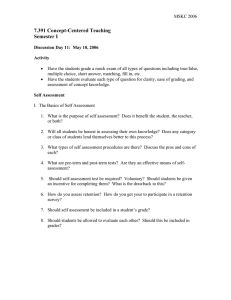Drawback Simplification Act - Alliance International CHB, Inc.
advertisement

Drawback Currents Newsletter Volume 2: Issue No. 5: HR 3443: Drawback Simplification Act Drawback Simplification Bill Introduced The Drawback Simplification Act of 2007 was recently introduced by Congressman Mike Thompson of California. The passage of the legislation is the first step in an overall plan to significantly reduce the burden associated with a currently complex regulatory and administrative environment for drawback claimants. The bill provides the legal framework that will allow Customs to incorporate drawback claim processing into the Automated Commercial Environment (ACE) To accomplish this, drawback processing must migrate from part number level detail to the level of the Harmonized Tariff Schedule Number (HTS). HR 3443 establishes the HTS as the new matching criteria for both manufacturing substitution as well as unused merchandise substitution drawback. What does this mean in practical terms? The average claimant should see a significant increase in drawback recovery should HTS become the standard for substitution. For example, currently a claimant of golf clubs must match exports to imports by a unique part number that incorporates the model and the loft of the club. Under the new law, an exported Model "X" 6 iron could be claimed against an Model "Y" 9 iron given that both fall into the same HTS number. Essentially by elevating the matching criteria from the part number level to the HTS level, claimants are given much more flexibility in identifying eligible import and export transactions. Also, the process of constructing claims for submission is simplified with eliminating the need to capture import duty paid at the part number level (for many drawback claimants an arduous manual keying process). Even if the legislation passes this year (too many political variable to even predict), full implementation is years away due to the need to revise the regulations as well as the daunting project of programming the drawback module within ACE. The good news is that if the legislation does pass, the ability to take advantage of the HTS substitution begins immediately for those filing under the provisions of unused merchandise substitution (goods imported and exported in essentially the same condition). To receive a copy of the proposed legislation or if you have questions, please email Alliance at alliance@alliancechb.com or call us at (415) 460-6500. Ask the Expert: What Impact did the NAFTA have on drawback filers exporting to Canada and Mexico? The implementation of NAFTA imposed a variety of restrictions on the drawback programs of all three countries. In the United States, the substitution provision of same condition drawback was no longer available on exports to Canada and Mexico. Under substitution, a claimant could export domestically sourced merchandise and still file a drawback claim if they also imported the same commercially interchangeable merchandise. Substitution also made the drawback filing process much less burdensome in that an export could be matched with any commercially interchangeable import of the same style number imported within three years prior or the export date. NAFTA does still allow same condition drawback on exports on Canada and Mexico under the filing method of direct identification. Under direct ID, the claimant must match exports to imports either specifically using a lot number of serial number or using one of the acceptable direct identification accounting methodologies. Additionnally, manufacturing drawback claimants must pass the "lesser than" rule which essentially limits drawback refunds to lesser of either the duty on the components imported into the United States or the duty on the finished product as it enters Canada or Mexico. Translation: If the finished product receives duty free treatment as it enters the commerce of either Canada or Mexico then no drawback refunds! Copyright 2007, Alliance International CHB, Inc. Site design by


